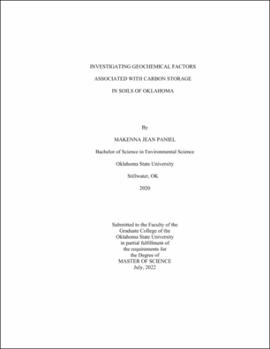| dc.contributor.advisor | Jilling, Andrea | |
| dc.contributor.author | Paniel, Makenna Jean | |
| dc.date.accessioned | 2023-04-12T19:38:35Z | |
| dc.date.available | 2023-04-12T19:38:35Z | |
| dc.date.issued | 2022-07 | |
| dc.identifier.uri | https://hdl.handle.net/11244/337372 | |
| dc.description.abstract | In the realm of both soil science and environmental science, controls on soil carbon sequestration are of interest to both scientists and citizens. Increasing soil carbon sequestration garners significant attention for its ability to mitigate climate change and ensure a sustainable future. However, there remains substantial gaps in the literature and current knowledge about the controls on soil organic matter (SOM) dynamics across time and climactic regimes. An understanding of the factors associated with SOM informs soil carbon models and the best practices for preserving and increasing carbon storage in the long-term. Further investigation into the geochemical controls of SOM dynamics in surface and subsurface soils could close these gaps. Current research points to discrepancy in the accumulation of SOM in surface and subsurface soils. This project delved into this discrepancy by examining the mechanisms underlying carbon storage across a range of soil types with the express intent of uncovering its controls. By using archived and collected soils from across a range of sites in Oklahoma, new analyses revealed where the SOM resides, how different metal phases interact with SOM formation, and theories for what drives the discrepancy observed in other studies. To accomplish this goal, the soils were fractionated into mineral-associated organic matter (MAOM) and particulate organic matter (POM) and tested for total organic carbon (TOC) concentration. In addition, whole soil samples were analyzed for iron, aluminum, magnesium, and calcium metal concentrations for extractable short-range order (SRO) minerals and organo-mineral complexes. These analyses showed a significant difference in TOC between fractions and different soil orders. Additionally, almost every metal phase had significant differences between soil orders and with pH. When fraction TOC data and metal phases are compared by acidic and basic soils, a significant correlation was found between TOC and iron and aluminum within SRO minerals in acidic soils as well as magnesium in organo-metal complexes in basic soils. As SRO iron and aluminum increase, TOC increases in acidic soils. Contrastingly, TOC decreases as magnesium in organo-metal complexes increase in basic soils. Clay, usually considered a predictor of TOC, had no correlation. Further studies could explore these relationships. | |
| dc.format | application/pdf | |
| dc.language | en_US | |
| dc.rights | Copyright is held by the author who has granted the Oklahoma State University Library the non-exclusive right to share this material in its institutional repository. Contact Digital Library Services at lib-dls@okstate.edu or 405-744-9161 for the permission policy on the use, reproduction or distribution of this material. | |
| dc.title | Investigating geochemical factors associated with carbon storage in soils of Oklahoma | |
| dc.contributor.committeeMember | Ochsner, Tyson | |
| dc.contributor.committeeMember | Hickman, Karen | |
| osu.filename | Paniel_okstate_0664M_17779.pdf | |
| osu.accesstype | Open Access | |
| dc.type.genre | Thesis | |
| dc.type.material | Text | |
| dc.subject.keywords | carbon sequestration | |
| dc.subject.keywords | geochemical | |
| dc.subject.keywords | mineral-associated organic matter | |
| dc.subject.keywords | Oklahoma Mesonet | |
| dc.subject.keywords | soil carbon | |
| dc.subject.keywords | soil organic matter | |
| thesis.degree.discipline | Plant and Soil Sciences | |
| thesis.degree.grantor | Oklahoma State University | |
